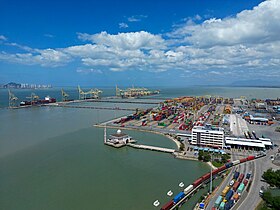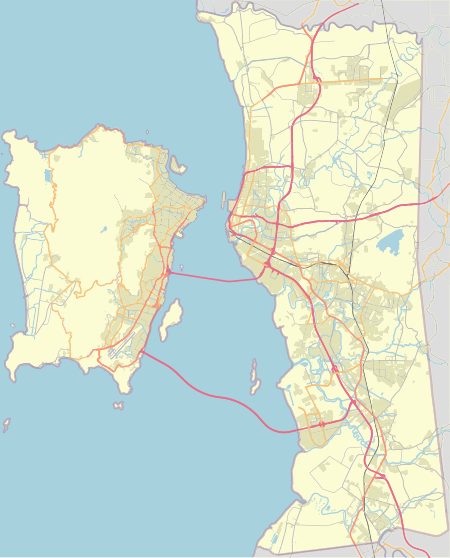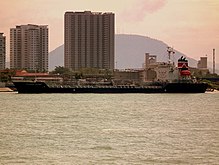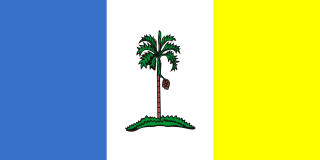
Penang is a Malaysian state located on the northwest coast of Peninsular Malaysia, by the Malacca Strait. It has two parts: Penang Island, where the capital city, George Town, is located, and Seberang Perai on the Malay Peninsula. These two halves are physically connected by the Penang Bridge and the Second Penang Bridge. The state shares borders with Kedah to the north and east, and Perak to the south.

George Town is the capital of the Malaysian state of Penang and the core city of the George Town Conurbation, Malaysia's second largest metropolitan area with a population of 2.84 million and the second highest contributor to the country's GDP. The city proper covers an area of 306 km2 (118 sq mi) and was home to a population of 794,313 as of 2020.
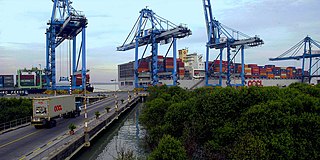
Port Klang is a town and the main gateway by sea into Malaysia. Known during colonial times as Port Swettenham but renamed Port Klang in July 1972, it is the largest port in the country. It is located about 6 kilometres (3.7 mi) southwest of the town of Klang, and 38 kilometres (24 mi) southwest of Kuala Lumpur.

Butterworth is the city centre of Seberang Perai in the Malaysian state of Penang. It lies about 3 km (1.9 mi) east of George Town, the capital city of Penang, across the Penang Strait. As of 2020, Butterworth had a total population of 80,378 residents.

The Port of Singapore is the collection of facilities and terminals that conduct maritime trade and handle Singapore's harbours and shipping. It has been ranked as the top maritime capital of the world, since 2015. Currently the world's second-busiest port in terms of total shipping tonnage, it also transships a fifth of the world's shipping containers, half of the world's annual supply of crude oil, and is the world's busiest transshipment port. It was also the busiest port in terms of total cargo tonnage handled until 2010, when it was surpassed by the Port of Shanghai.

Seberang Perai is a city in the Malaysian state of Penang. It is situated on the Malay Peninsula opposite Penang Island, bordering Kedah to the north and east and Perak to the south. Its city centre is located in Butterworth, while its local authority, the Seberang Perai City Council, is centred near Bukit Mertajam. As of 2020, Seberang Perai had a population of 946,000, making it the third most populous city in Malaysia.

Bukit Mertajam(Jawi: بوكيت مرتاجم) is the administrative centre of the city of Seberang Perai in Penang, Malaysia. It also serves as the seat of the Central Seberang Perai District. As of 2010, Bukit Mertajam (core) contains a total of 13,097 residents.

Perai is an urban settlement in the city of Seberang Perai, Penang, Malaysia. It lies at the southern bank of the Perai River and borders Butterworth to the north. Perai gave its name to the city of Seberang Perai, the mainland half of the State of Penang.

The State of Penang, one of the most developed and urbanised Malaysian states, is located at the nation's northwest coast along the Malacca Strait. Unlike most Malaysian states, the history of modern Penang was shaped by British colonialism, beginning with the acquisition of Penang Island from the Sultanate of Kedah by the British East India Company in 1786. Developed into a free port, the city state was subsequently governed as part of the Straits Settlements, together with Singapore and Malacca; the state capital, George Town, briefly became the capital of this political entity between 1826 and 1832. By the end of the 19th century, George Town prospered and became one of the major entrepôts in Southeast Asia.

The Penang Strait is an 11 kilometre-wide strait that separates Penang Island from mainland Malay Peninsula. Penang Island is to the west of the channel, while Seberang Perai, the mainland half of the State of Penang, is to the east. The northern and southern ends of the channel join the Strait of Malacca, one of the world's busiest maritime routes.

The State of Penang in Malaysia, home to the country's third largest city as well as part of Malaysia's second most populous conurbation, has a relatively well-developed transport infrastructure. The city-state is well-connected by land, air and sea; the Penang International Airport is one of Malaysia's busiest, while the Port of Penang is the main harbour and transshipment hub within northern Malaysia. The North–South Expressway, the main highway along western Peninsular Malaysia, runs through Penang, while the two geographically separate halves of the state are now linked by two bridges and a ferry service.

The North-East District is a district within the Malaysian state of Penang. The district covers the northeastern half of Penang Island, including the centre of George Town, Penang's capital city. It has an area of 122.79 km2 (47.41 sq mi) and a population of 510,996 as of 2010. The district borders the South-West District (Penang)|South-West District to the south-west.

The Butterworth railway station is a Malaysian railway station located at and named after the town of Butterworth, Penang.

The Malaysian Expressway System is a network of national controlled-access expressways in Malaysia that forms the primary backbone network of Malaysian national highways. The network begins with the Tanjung Malim–Slim River tolled road which was opened to traffic on 16 March 1966, later North–South Expressway (NSE), and is being substantially developed. Malaysian expressways are built by private companies under the supervision of the government highway authority, Malaysian Highway Authority.

The Greater Penang Conurbation, also known as the George Town Conurbation, is the built-up urban or metropolitan area within and around the Malaysian state of Penang. Encompassing all of Penang, and parts of the neighbouring states of Kedah and Perak, the conurbation was home to over 2.84 million people as of 2020, the second largest in the country after the Klang Valley.

Weld Quay is a coastal road in the city of George Town within the Malaysian state of Penang. One of a handful of places worldwide that was named after a Prime Minister of New Zealand, the road runs along the city's eastern shoreline, connecting the Tun Dr. Lim Chong Eu Expressway with Light Street and Beach Street.
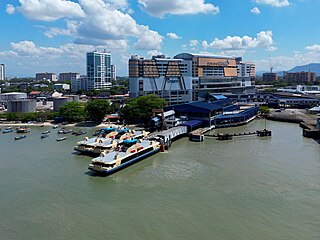
The Sultan Abdul Halim Ferry Terminal is a ferry slip within Seberang Perai in the Malaysian state of Penang. Situated at Butterworth, this docking facility is used for the state's ferry service between the city and George Town, which lies across the Penang Strait.

George Town, the capital city of the State of Penang, is the second largest city in Malaysia and the economic centre of the country's northern region. The history of George Town began with its establishment by Captain Francis Light of the British East India Company in 1786. Founded as a free port, George Town became the first British settlement in Southeast Asia and prospered in the 19th century as one of the vital British entrepôts within the region. It briefly became the capital of the Straits Settlements, a British crown colony which also consisted of Singapore and Malacca.

Swettenham Pier is a pier within the city of George Town in Penang, Malaysia. Established in 1904, it is the busiest port-of-call in Malaysia for cruise shipping. The pier plays a vital role as a major entry point for tourists into Penang, aside from the Penang International Airport and land connections.

Central George Town is the city centre of George Town, the capital of the Malaysian state of Penang. It corresponds to the eponymous mukim of George Town, which is mostly identical to the original city limits established when George Town was granted city status in 1957.
